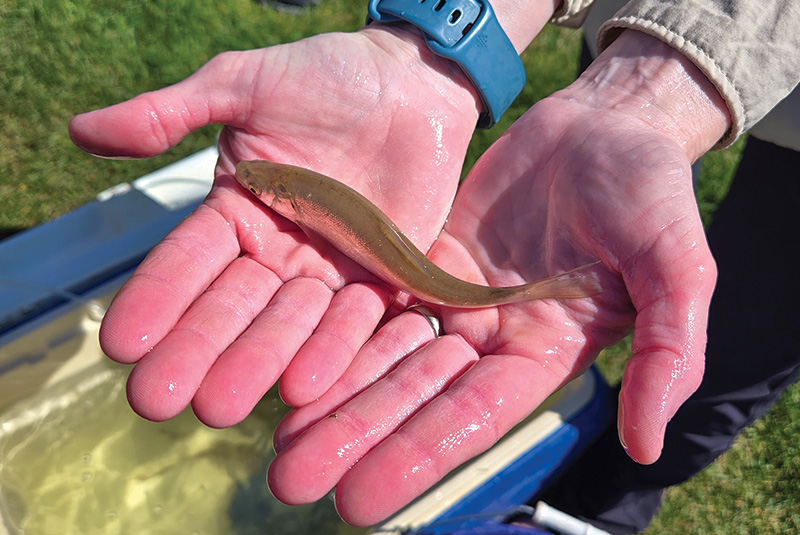
A Virgin River chub fingerling before its introduction to a Black Desert Resort lake. Photo by Joseph Platt
From the beginning, Joseph Platt, Ph.D., was upfront about the risks of introducing the endangered Virgin River chub into one of the lakes at Black Desert Resort.
The fish, which is found only in the Virgin River that winds its way from (and through the millennium actually carved out) Zion National Park before emptying in Lake Mead, has been listed as an endangered species since 1989. Platt, an adjunct professor of biological sciences at Utah Tech University and director of environmental services for Black Desert Resort in Ivins, Utah, negotiated for months with various agencies in and around Utah before securing 400 Virgin River chub fingerlings this past March.
The 11-month-old fish were installed in one of six lakes on the property, which in October hosted the Black Desert Championship, the first PGA Tour event in Utah in 63 years. Platt, a one-year Educator member of GCSAA, offered no guarantees.
“They totally accepted it as an experiment,” Platt says. “The state agreed that it was an experiment. If everything went south, they wouldn’t hold us liable.”
Preliminary results proved the experiment did not, in fact, go south.
Before the transplanted chub headed to deep water as the weather warmed, Platt says they had grown from fingerlings to 8-to-10 inches in length. An attempt to net them last month was called off due to bad weather, but it will be attempted again to see if the fish are breeding as well as growing.
“The best news we could get is that they’re breeding,” Platt says. “But it’s not a given because they came in so small. They would have had to breed in April or May, but were they sexually mature? We don’t know. It might be that they just survived, but that’s a plus. Survival is important. Growth is important.”
The purpose of the Virgin River chub experiment at Black Desert Resort, where Ken Yates, a 13-year association member, is the GCSAA Class A superintendent, is twofold. Platt hopes that, if successful, the project could bolster the rare fish’s numbers, and the resort could serve as a refuge should the Virgin River population suffer a catastrophic event. Second, Platt says education about the fish — which is protected under the federal Endangered Species Act — is a crucial component.
“It’s all focused on education,” he says. “We have signs put up, teaching people about what they’re looking at.”
The Virgin River chub, Platt says, was a key food source first for local Native Americans and early settlers, but pollution, drought, development and invasive species “decimated” the population. The Global Conservation Scale — which runs from GX (presumed extinct), to GH (possibly extinct) to G1-G5 — has the Virgin River chub at G1 (critically imperiled, or just one step above possibly extinct).
The fish is raised at only one location, the Wahweap Fish Hatchery in Big Water, Utah, and even there the breeding is so uncertain that Platt didn’t know how many fingerlings the resort would receive until the day before they arrived.
Of the course’s six lakes, two, Platt says, feature waterfalls, which render them chub-unfriendly.
The current chubified lake is located by the No. 6 hole’s fairway. The resort has been approved for another chub infusion next year, and Platt says by adding to the current population and expanding to another lake near the No. 13 hole, it could take another few hundred fish. “What I want is for them to be centrally located, where all the people are walking around,” Platt says.
The Virgin River chub project is just one of Black Desert Resort’s wildlife initiatives. Another involves the endangered Mojave Desert tortoise, which is indigenous, and which has a “lovely population” in the Red Cliffs Desert Reserve that borders Black Desert Resort. Platt is negotiating with myriad agencies to be given permission to create a natural habitat for the tortoises to live in the still-to-be-constructed education center.
“You can walk around the (69,000-acre) reserve and hope you see one, or you can go to one place in an office building that is part of the reserve and see a couple of tortoises walking around,” Platt says. “We talk about their plight and how we’re helping them and would like to give people the opportunity where the tortoises can actually be seen.”
Another project is a pollinator garden that’s the result of a partnership with the Utah Department of Agriculture. Black Desert Resort applied for and was granted 300 potted plants — the product of a northern Utah prison inmate project that produced thousands of native plants — that were planted in the resort’s pollinator garden. It’s monarch butterfly friendly, but it’s also crucial, Platt says, to help support the hundreds of bee and butterfly species native to the area.
“When the construction stops here at Black Desert and we can landscape,” Platt says, “we’ll landscape with these native plants, and we’ll have these cool signs that tell the story of what the pollinator gardens are and how people can help.”
Andrew Hartsock is GCM’s editor-in-chief.